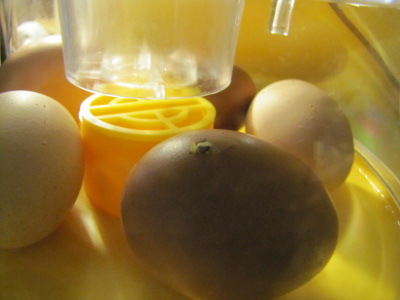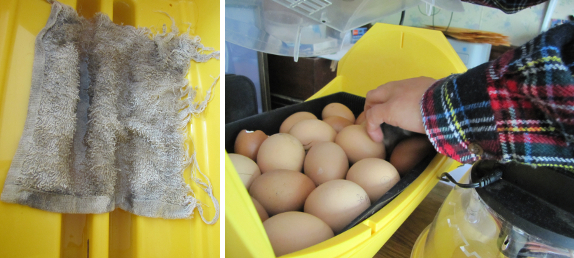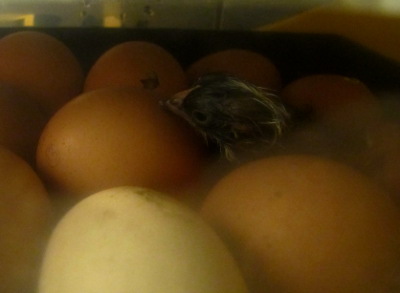
Musing during hatch
 I
still don't know how successful this
hatch will be, but fifteen hours into day 21, there are now two fully
fluffed chicks in the brooder, one wet chick flopping its
way out of the shell, and five more pipping. I've got a lot of
thoughts on the process so far:
I
still don't know how successful this
hatch will be, but fifteen hours into day 21, there are now two fully
fluffed chicks in the brooder, one wet chick flopping its
way out of the shell, and five more pipping. I've got a lot of
thoughts on the process so far:
- All of this activity has taken place in one half of the
incubator, making me wonder if temperatures aren't exactly the same
throughout. Perhaps next time I should flip the orientation of
the egg tray each time I weigh
it?
- Or maybe hatch time varies by breed? All of the fully
hatched chicks are my mail-ordered cuckoo maran eggs, and so are a
couple of the pippers.

- Humidity isn't so hard to deal with during hatch as people make it seem. Adding a wet washcloth to the bottom of the incubator under the wells and pouring in a bit of baby bottle temperature water whenever I mess around inside lets me keep humidity in the incubator quite high with the vent partly open, and the humidity rebounds in minutes when I have to open the lid.
- I was overreacting about space
in the incubator. All of the chicks who have hatched so far
have been brimming with life, not soft and easily damaged like the ones
that died in the incubator last time. Since the chicks hatch over
quite a long time period, I can take out dried off chicks and empty
shells at intervals, leaving more space for each newly hatched bird.
 That said, I still had
nightmares and woke up three times during night 20, coming in with a
flashlight to check on the eggs. In an effort to ease my mind and
get a full night's sleep for night 21, I downloaded three free ebooks
about incubation, the most useful of which has been Incubation: Natural and Artificial
by J.H. Sutcliffe. Yes, this book is over a century old, but I
was looking for tried and true information. I learned that my gut
feeling that I should turn any pipped eggs upright if their hole is
pointing to the floor instead of the ceiling is right on track and that
you can tell if an unpipped egg is alive on day 21 by using the witch
test (you know, put it in some warm water and see if it floats.) I'll save that last
tidbit of information for an emergency.
That said, I still had
nightmares and woke up three times during night 20, coming in with a
flashlight to check on the eggs. In an effort to ease my mind and
get a full night's sleep for night 21, I downloaded three free ebooks
about incubation, the most useful of which has been Incubation: Natural and Artificial
by J.H. Sutcliffe. Yes, this book is over a century old, but I
was looking for tried and true information. I learned that my gut
feeling that I should turn any pipped eggs upright if their hole is
pointing to the floor instead of the ceiling is right on track and that
you can tell if an unpipped egg is alive on day 21 by using the witch
test (you know, put it in some warm water and see if it floats.) I'll save that last
tidbit of information for an emergency.
Photos this morning
aren't very inspired since it's not quite daylight and my photographer
(Mark) is still sound asleep. I'm sure you'll see more cute
pictures tonight.
Want more in-depth information? Browse through our books.
Or explore more posts by date or by subject.
About us: Anna Hess and Mark Hamilton spent over a decade living self-sufficiently in the mountains of Virginia before moving north to start over from scratch in the foothills of Ohio. They've experimented with permaculture, no-till gardening, trailersteading, home-based microbusinesses and much more, writing about their adventures in both blogs and books.
Want to be notified when new comments are posted on this page? Click on the RSS button after you add a comment to subscribe to the comment feed, or simply check the box beside "email replies to me" while writing your comment.

I think you hit the nail on the head. I was reading in the incubation ebook that hens older than two years produce eggs with lower hatch rates, and our old hens are old. When I look back at my notes, both of the chicks that made it out of the shell last time around were from our younger hen (although she's still past the two year mark.) Not thinking of that (and wanting the good foraging genetics), the 12 Golden Comet eggs I put in this time around were nearly all from the old hens (9 to 3), so I don't think I should expect much from them.
That said, three of the old hen eggs are currently pipping! I suspect they'll need help if they're going to make it, so I need to decide whether those potentially weakened chicks are worth helping out of the egg.
In more pleasant news, we now have four living cuckoo marans chicks in the brooder, and two more pipping!